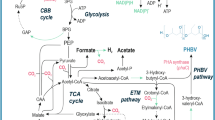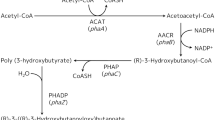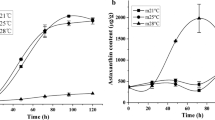Abstract
Poly(3-hydroxybutyrate) [P(3HB)], a polymer belonging to the polyhydroxyalkanoate (PHA) family, is accumulated by numerous bacteria as carbon and energy storage material. The mobilization of accumulated P(3HB) is associated with increased stress and starvation tolerance. However, the potential function of accumulated copolymer such as poly(3-hydroxybutyrate-co-3-hydroxyvalerate) [P(3HB-co-3HV)] remained unknown. In this study, Delftia acidovorans DS 17 was used to evaluate the contributions of P(3HB) and P(3HB-co-3HV) granules during simulated exogenous carbon deprivation on cell survival by transferring cells with PHAs to carbon-free mineral salt medium supplemented with 1 % (w/v) nitrogen source. By mobilizing the intracellular P(3HB) and P(3HB-co-3HV) at 11 and 40 mol% 3HV compositions, the cells survived starvation. Surprisingly, D. acidovorans containing P(3HB-co-94 mol% 3HV) also survived although the mobilization was not as effective. Similarly, recombinant Escherichia coli pGEM-T::phbCAB Cn (harboring the PHA biosynthesis genes of Cupriavidus necator) containing P(3HB) granules had a higher viable cell counts compared to those without P(3HB) granules but without any P(3HB) mobilization when exposed to oxidative stress by photoactivated titanium dioxide. This study provided strong evidence that enhancement of stress tolerance in PHA producers can be achieved without mobilization of the previously accumulated granules. Instead, PHA biosynthesis may improve bacterial survival via multiple mechanisms.





Similar content being viewed by others
References
Sudesh, K., Abe, H., & Doi, Y. (2000). Progress in Polymer Science, 25(10), 1503–1555.
Kadouri, D., Jurkevitch, E., Okon, Y., & Castro-Sowinski, S. (2005). Critical Reviews in Microbiology, 31(2), 55–67.
Yu, J. (2006). Microbial production of bioplastics from renewable resources. In S. T. Yang (Ed.), Bioprocessing of value added products from renewable resources (pp. 585–610). Amsterdam: Elsevier.
Sudesh, K., & Iwata, T. (2008). CLEAN, 36(5–6), 433–442.
Keshavarz, T., & Roy, I. (2010). Current Opinion in Microbiology, 13(3), 321–326.
Castro-Sowinski, S., Burdman, S., Matan, O., & Okon, Y. (2010). Natural functions of bacterial polyhydroxyalkanoates. In G.-Q. Chen (Ed.), Plastics from bacteria: natural functions and applications (Microbiology monographs, Vol. 14, pp. 39–61). Heidelberg: Springer.
Tribelli, P. M., & Lopez, N. I. (2011). Extremophiles, 15, 541–547.
Wang, Q., Yu, H., Xia, Y., Kang, Z., & Qi, Q. (2009). Microbial Cell Factories, 8(47), 47–55.
Handrick, R., Reinhardt, S., & Jendrossek, D. (2000). Journal of Bacteriology, 182(20), 5916–5918.
Ratcliff, W. C., Kadam, S. V., & Denison, R. F. (2008). FEMS Microbiology Ecology, 65, 391–399.
James, B. W., Mauchline, W. S., Dennis, P. J., Keevil, C. W., & Wait, R. (1999). Applied and Environmental Microbiology, 65(2), 822–827.
Ruiz, J. A., López, N. I., Fernandez, R. O., & Mendez, B. S. (2001). Applied and Environmental Microbiology, 67(1), 225–230.
Ayub, N. D., Pettinari, M. J., Ruiz, J. A., & López, N. I. (2004). Current Opinion in Microbiology, 49(3), 170–174.
Ayub, N., Tribelli, P., & López, N. (2009). Extremophiles, 13(1), 59–66.
Zhao, Y. H., Li, H. M., Qin, L. F., Wang, H. H., & Chen, G.-Q. (2007). FEMS Microbiology Letters, 276(1), 34–41.
Raiger-Iustman, L. J., & Ruiz, J. A. (2008). FEMS Microbiology Letters, 284(2), 218–224.
Jendrossek, D. (2009). Journal of Bacteriology, 191(10), 3195–3202.
Tessmer, N., Konig, S., Malkus, U., Reichelt, R., Potter, M., & Steinbuchel, A. (2007). Microbiology, 153(2), 366–374.
Jiyeun, K. K., Yeo, J. W., Naruo, N., Hiroshi, N., Sang, H. H., Yoshitomo, K., et al. (2013). Proceedings of the National Academy of Sciences of the United States of America, 110(26), E2381–E2389. doi:10.1073/pnas.1303228110.
Uchino, K., Saito, T., Gebauer, B., & Jendrossek, D. (2007). Journal of Bacteriology, 189(22), 8250–8256.
Braunegg, G., Sonnleitner, B., & Lafferty, R. M. (1978). European Journal of Applied Microbiology and Biotechnology, 6, 29–37.
Bradford, M. M. (1976). Analytical Biochemistry, 72(1–2), 248–254.
Jendrossek, D., & Handrick, R. (2002). Annual Review of Microbiology, 56, 403–432.
Huang, Z., Maness, P.-C., Blake, D. M., Wolfrum, E. J., Smolinski, S. L., & Jacoby, W. A. (2000). Journal of Photochemistry and Photobiology A: Chemistry, 130(2–3), 163–170.
Maness, P.-C., Smolinski, S., Blake, D. M., Huang, Z., Wolfrum, E. J., & Jacoby, W. A. (1999). Applied and Environmental Microbiology, 65(9), 4094–4098.
Yan, Y.-B., Wu, Q., & Zhang, R.-Q. (2000). FEMS Microbiology Letters, 193(2), 269–273.
Handrick, R., Reinhardt, S., Kimmig, P., & Jendrossek, D. (2004). Journal of Bacteriology, 186(21), 7243–7253.
Potter, M., Muller, H., Reinecke, F., Wieczorek, R., Fricke, F., Bowien, B., et al. (2004). Microbiology, 150(7), 2301–2311.
Rehm, B. H. A. (2010). Nature Reviews. Microbiology, 8, 578–592.
Yamada, M., Wakuda, A., & Taguchi, S. (2007). Bioscience, Biotechnology, and Biochemistry, 71(6), 1572–1576.
Ruiz, J. A., López, N. I., & Mendez, B. S. (2004). Current Microbiology, 48(6), 396–400.
Eisenstark, A., Calcutt, M. J., Becker-Hapak, M., & Ivanova, A. (1996). Free Radical Biology and Medicine, 21(7), 975–993.
Moreau, P. L. (2004). Journal of Bacteriology, 186(21), 7364–7368.
Nyström, T. (2003). Cellular and Molecular Life Sciences, 60(7), 1333–1341.
Nyström, T. (2004). Annual Review of Microbiology, 58(1), 161–181.
Ireland, J. C., Klostermann, P., Rice, E. W., & Clark, R. M. (1993). Applied and Environmental Microbiology, 59(5), 1668–1670.
Pavasupree, S., Suzuki, Y., Pivsa-Art, S., & Yoshikawa, S. (2005). Journal of Solid State Chemistry, 178(1), 128–134.
Jacoby, W. A., Maness, P. C., Wolfrum, E. J., Blake, D. M., & Fennell, J. A. (1998). Environmental Science and Technology, 32(17), 2650–2653.
Grage, K., Jahns, A. C., Parlane, N., Palanisamy, R., Rasiah, I. A., Atwood, J. A., et al. (2009). Biomacromolecules, 10(4), 660–669.
Sudesh, K., Maehara, A., Gan, Z., Iwata, T., & Doi, Y. (2004). Polymer Degradation and Stability, 83(2), 281–287.
Franke, R., & Franke, C. (1999). Chemosphere, 39(15), 2651–2659.
Acknowledgments
This work forms part of a study funded by the Long Term Research Grant Scheme (LRGS) project supported by the Ministry of Higher Education (MOHE), Malaysia. The authors thank Prof. Yoshiharu Doi for the D. acidovorans and recombinant E. coli strain. Prof. John Leslie’s help in editing the manuscript is gratefully acknowledged.
Author information
Authors and Affiliations
Corresponding author
Rights and permissions
About this article
Cite this article
Goh, LK., Purama, R.K. & Sudesh, K. Enhancement of Stress Tolerance in the Polyhydroxyalkanoate Producers without Mobilization of the Accumulated Granules. Appl Biochem Biotechnol 172, 1585–1598 (2014). https://doi.org/10.1007/s12010-013-0634-z
Received:
Accepted:
Published:
Issue Date:
DOI: https://doi.org/10.1007/s12010-013-0634-z




